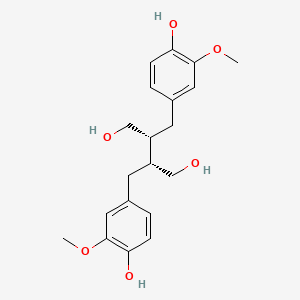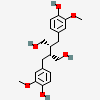Secoisolariciresinol
- Secoisolariciresinol
- 29388-59-8
- (-)-Secoisolariciresinol
- (2R,3R)-2,3-bis[(4-hydroxy-3-methoxyphenyl)methyl]butane-1,4-diol
- 1,4-Butanediol, 2,3-bis[(4-hydroxy-3-methoxyphenyl)methyl]-, (2R,3R)-
- Create:2005-08-01
- Modify:2025-01-18

- 2,3-bis((4-hydroxy-3-methoxyphenyl)methyl)-1,4-butanediol
- knotolan
- secoisolariciresinol
- secoisolariciresinol, (R*,S*)-isomer
- Secoisolariciresinol
- 29388-59-8
- (-)-Secoisolariciresinol
- (2R,3R)-2,3-bis[(4-hydroxy-3-methoxyphenyl)methyl]butane-1,4-diol
- 1,4-Butanediol, 2,3-bis[(4-hydroxy-3-methoxyphenyl)methyl]-, (2R,3R)-
- M8QRJ7JEJH
- CHEMBL368347
- CHEBI:65004
- (2R,3R)-2,3-bis(4-hydroxy-3-methoxybenzyl)butane-1,4-diol
- (2R*,3R*)-2,3-Bis(4-hydroxy-3-methoxybenzyl)-1,4-butanediol
- (2R,3R)-2,3-bis[(3-methoxy-4-oxidanyl-phenyl)methyl]butane-1,4-diol
- CCRIS 7790
- UNII-M8QRJ7JEJH
- EINECS 249-599-2
- GO6
- RR-secoisolariciresinol
- (-) secoisolariciresinol
- secoisolariciresinol-(-)
- (+/-)-Secoisolariciresinol
- 8R,8'R-secoisolariciresinol
- MLS001424213
- SCHEMBL12427083
- DTXSID50183615
- HMS2052G03
- HMS2232J05
- HY-N6071
- SECOISOLARICIRESINOL, (-)-
- BDBM50240914
- MFCD01075136
- (R-(R*,R*))-2,3-Bis((4-hydroxy-3-methoxyphenyl)methyl)butane-1,4-diol
- AKOS032948353
- CCG-101074
- DB12179
- NC00324
- 1,4-Butanediol, 2,3-bis((4-hydroxy-3-methoxyphenyl)methyl)-, (R-(R*,R*))-
- NCGC00346838-01
- AS-78311
- DA-67513
- Secoisolariciresinol, >=95.0% (HPLC)
- SMR000469212
- (8R,8'R)-(-)-SECOISOLARICIRESINOL
- CS-0032316
- NS00028683
- C18167
- A876479
- 1,4-BUTANEDIOL, 2,3-DIVANILLYL-, (-)-
- Q-100372
- Q4413253
- BRD-K91733562-001-05-0
- 2,3-Bis(4-hydroxy-3-methoxybenzyl)-1,4-butanediol, (-)
- (2R,3R)-2,3-bis[(4-hydroxy-3-methoxy-phenyl)methyl]butane-1,4-diol
- 1,4-Butanediol,2,3-bis[(4-hydroxy-3-methoxyphenyl)methyl]-, (2R,3R)-
122.03574 100
137.05365 96.20
138.07034 50.60
131.04947 46.80
116.06033 34.20
137.06427 100
131.0546 35.20
124.04817 28.60
236.12799 28.60
133.06233 26.40
137.05693 999
327.16397 640
163.07758 349
133.06633 302
138.0636 255
137.05914 999
163.07651 200
133.06491 170
131.05063 162
122.03461 111
Patents are available for this chemical structure:
https://patentscope.wipo.int/search/en/result.jsf?inchikey=PUETUDUXMCLALY-HOTGVXAUSA-N
- CAS Common ChemistryLICENSEThe data from CAS Common Chemistry is provided under a CC-BY-NC 4.0 license, unless otherwise stated.https://creativecommons.org/licenses/by-nc/4.0/(-)-Secoisolariciresinolhttps://commonchemistry.cas.org/detail?cas_rn=29388-59-8
- ChemIDplusSecoisolariciresinolhttps://pubchem.ncbi.nlm.nih.gov/substance/?source=chemidplus&sourceid=0029388598ChemIDplus Chemical Information Classificationhttps://pubchem.ncbi.nlm.nih.gov/source/ChemIDplus
- DrugBankLICENSECreative Common's Attribution-NonCommercial 4.0 International License (http://creativecommons.org/licenses/by-nc/4.0/legalcode)https://www.drugbank.ca/legal/terms_of_useSecoisolariciresinolhttps://www.drugbank.ca/drugs/DB12179
- EPA DSSToxSecoisolariciresinolhttps://comptox.epa.gov/dashboard/DTXSID50183615CompTox Chemicals Dashboard Chemical Listshttps://comptox.epa.gov/dashboard/chemical-lists/
- European Chemicals Agency (ECHA)LICENSEUse of the information, documents and data from the ECHA website is subject to the terms and conditions of this Legal Notice, and subject to other binding limitations provided for under applicable law, the information, documents and data made available on the ECHA website may be reproduced, distributed and/or used, totally or in part, for non-commercial purposes provided that ECHA is acknowledged as the source: "Source: European Chemicals Agency, http://echa.europa.eu/". Such acknowledgement must be included in each copy of the material. ECHA permits and encourages organisations and individuals to create links to the ECHA website under the following cumulative conditions: Links can only be made to webpages that provide a link to the Legal Notice page.https://echa.europa.eu/web/guest/legal-notice[R-(R*,R*)]-2,3-bis[(4-hydroxy-3-methoxyphenyl)methyl]butane-1,4-diolhttps://echa.europa.eu/substance-information/-/substanceinfo/100.045.076
- FDA Global Substance Registration System (GSRS)LICENSEUnless otherwise noted, the contents of the FDA website (www.fda.gov), both text and graphics, are not copyrighted. They are in the public domain and may be republished, reprinted and otherwise used freely by anyone without the need to obtain permission from FDA. Credit to the U.S. Food and Drug Administration as the source is appreciated but not required.https://www.fda.gov/about-fda/about-website/website-policies#linkingSECOISOLARICIRESINOLhttps://gsrs.ncats.nih.gov/ginas/app/beta/substances/M8QRJ7JEJH
- Human Metabolome Database (HMDB)LICENSEHMDB is offered to the public as a freely available resource. Use and re-distribution of the data, in whole or in part, for commercial purposes requires explicit permission of the authors and explicit acknowledgment of the source material (HMDB) and the original publication (see the HMDB citing page). We ask that users who download significant portions of the database cite the HMDB paper in any resulting publications.http://www.hmdb.ca/citingSecoisolariciresinolhttp://www.hmdb.ca/metabolites/HMDB0013692HMDB0013692_msms_2236448https://hmdb.ca/metabolites/HMDB0013692#spectra
- ChEBI(-)-secoisolariciresinolhttps://www.ebi.ac.uk/chebi/searchId.do?chebiId=CHEBI:65004
- LOTUS - the natural products occurrence databaseLICENSEThe code for LOTUS is released under the GNU General Public License v3.0.https://lotus.nprod.net/Secoisolariciresinolhttps://www.wikidata.org/wiki/Q4413253LOTUS Treehttps://lotus.naturalproducts.net/
- Open TargetsLICENSEDatasets generated by the Open Targets Platform are freely available for download.https://platform-docs.opentargets.org/licence(+)-SECOISOLARICIRESINOLhttps://platform.opentargets.org/drug/CHEMBL368347
- ChEMBLLICENSEAccess to the web interface of ChEMBL is made under the EBI's Terms of Use (http://www.ebi.ac.uk/Information/termsofuse.html). The ChEMBL data is made available on a Creative Commons Attribution-Share Alike 3.0 Unported License (http://creativecommons.org/licenses/by-sa/3.0/).http://www.ebi.ac.uk/Information/termsofuse.htmlChEMBL Protein Target Treehttps://www.ebi.ac.uk/chembl/g/#browse/targets
- ClinicalTrials.govLICENSEThe ClinicalTrials.gov data carry an international copyright outside the United States and its Territories or Possessions. Some ClinicalTrials.gov data may be subject to the copyright of third parties; you should consult these entities for any additional terms of use.https://clinicaltrials.gov/ct2/about-site/terms-conditions#Use
- Comparative Toxicogenomics Database (CTD)LICENSEIt is to be used only for research and educational purposes. Any reproduction or use for commercial purpose is prohibited without the prior express written permission of NC State University.http://ctdbase.org/about/legal.jspsecoisolariciresinolhttps://ctdbase.org/detail.go?type=chem&acc=C060283
- FooDBLICENSEFooDB is offered to the public as a freely available resource. Use and re-distribution of the data, in whole or in part, for commercial purposes requires explicit permission of the authors and explicit acknowledgment of the source material (FooDB) and the original publication.https://foodb.ca/about(+)-Secoisolariciresinolhttps://foodb.ca/compounds/FDB001441(8R,8'R)-Secoisolariciresinolhttps://foodb.ca/compounds/FDB021314
- Japan Chemical Substance Dictionary (Nikkaji)
- KEGGLICENSEAcademic users may freely use the KEGG website. Non-academic use of KEGG generally requires a commercial licensehttps://www.kegg.jp/kegg/legal.htmlPhytochemical compoundshttp://www.genome.jp/kegg-bin/get_htext?br08003.keg
- Natural Product Activity and Species Source (NPASS)(+)-Secoisolariciresinolhttps://bidd.group/NPASS/compound.php?compoundID=NPC85488
- MassBank EuropeSecoisolariciresinolhttps://massbank.eu/MassBank/Result.jsp?inchikey=PUETUDUXMCLALY-HOTGVXAUSA-N
- MassBank of North America (MoNA)LICENSEThe content of the MoNA database is licensed under CC BY 4.0.https://mona.fiehnlab.ucdavis.edu/documentation/license
- Metabolomics WorkbenchSecoisolariciresinolhttps://www.metabolomicsworkbench.org/data/StructureData.php?RegNo=42480
- NCI Thesaurus (NCIt)LICENSEUnless otherwise indicated, all text within NCI products is free of copyright and may be reused without our permission. Credit the National Cancer Institute as the source.https://www.cancer.gov/policies/copyright-reuseNCI Thesaurushttps://ncit.nci.nih.gov
- NORMAN Suspect List ExchangeLICENSEData: CC-BY 4.0; Code (hosted by ECI, LCSB): Artistic-2.0https://creativecommons.org/licenses/by/4.0/SecoisolariciresinolNORMAN Suspect List Exchange Classificationhttps://www.norman-network.com/nds/SLE/
- Protein Data Bank in Europe (PDBe)
- RCSB Protein Data Bank (RCSB PDB)LICENSEData files contained in the PDB archive (ftp://ftp.wwpdb.org) are free of all copyright restrictions and made fully and freely available for both non-commercial and commercial use. Users of the data should attribute the original authors of that structural data.https://www.rcsb.org/pages/policies
- Rhea - Annotated Reactions DatabaseLICENSERhea has chosen to apply the Creative Commons Attribution License (http://creativecommons.org/licenses/by/4.0/). This means that you are free to copy, distribute, display and make commercial use of the database in all legislations, provided you credit (cite) Rhea.https://www.rhea-db.org/help/license-disclaimer
- SpectraBase(2R,3R)-2,3-bis[(3-methoxy-4-oxidanyl-phenyl)methyl]butane-1,4-diolhttps://spectrabase.com/spectrum/FWaTAHJ4U9t(2R,3R)-2,3-bis[(3-methoxy-4-oxidanyl-phenyl)methyl]butane-1,4-diolhttps://spectrabase.com/spectrum/L3USPxQAPun
- Springer Nature
- The Cambridge Structural Database
- Thieme ChemistryLICENSEThe Thieme Chemistry contribution within PubChem is provided under a CC-BY-NC-ND 4.0 license, unless otherwise stated.https://creativecommons.org/licenses/by-nc-nd/4.0/
- Wikidatasecoisolariciresinolhttps://www.wikidata.org/wiki/Q4413253
- WikipediaSecoisolariciresinolhttps://en.wikipedia.org/wiki/Secoisolariciresinol
- PubChem
- Medical Subject Headings (MeSH)LICENSEWorks produced by the U.S. government are not subject to copyright protection in the United States. Any such works found on National Library of Medicine (NLM) Web sites may be freely used or reproduced without permission in the U.S.https://www.nlm.nih.gov/copyright.htmlsecoisolariciresinolhttps://www.ncbi.nlm.nih.gov/mesh/67060283Phytoestrogenshttps://www.ncbi.nlm.nih.gov/mesh/68048789
- MolGenieMolGenie Organic Chemistry Ontologyhttps://github.com/MolGenie/ontology/
- PATENTSCOPE (WIPO)SID 389175410https://pubchem.ncbi.nlm.nih.gov/substance/389175410
- NCBI





